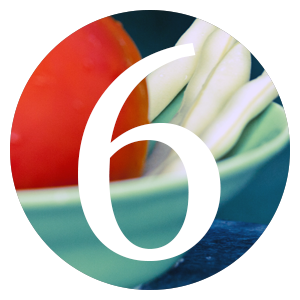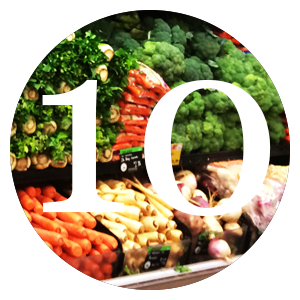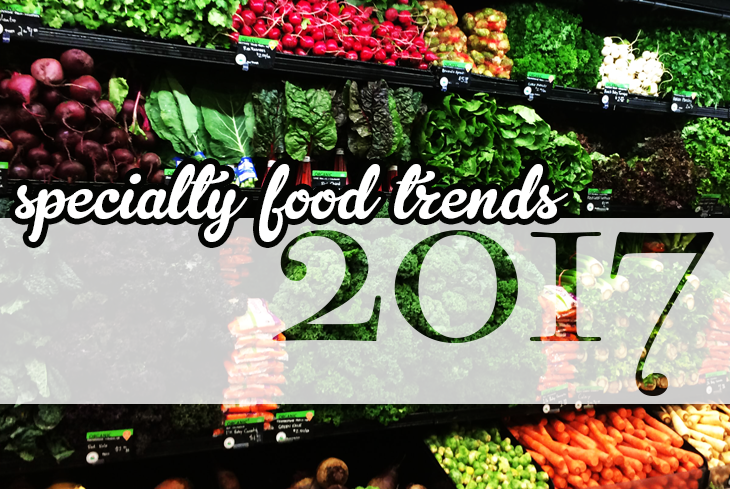About a year ago, we reviewed top 10 specialty food trends for 2016 inspired by Specialty Food Association (SFA); and can you believe it? Another new year is starting. We’re always keeping our sights on these new trends in food innovation, consumer eating-pattern changes and lifestyle shifts in order to have the best advice and perspective for our clients. Will the trends continue? Or should marketers and retailers keep their eyes open for a new direction? We’ve listed ten more specialty food trends that we’ve noticed throughout the year that we predict will flourish in the new year.

Paleolithic diet (paleo)*
You’ve probably heard of it. Paleo, or ‘Caveman Diet’ is a diet that is based on avoiding not just modern processed foods, but also foods that humans began eating after the Neolithic Revolution. While wide variability exists in the way the diet is interpreted, we’re noticing more attempts at marketing food products using this term. While we always suggest emulating the Canadian Food Guide for adequate nutrition plans, we couldn’t help but notice this term being used often–especially in whole food and clean eating choices.

Baking Alternatives
In addition to embracing an increasingly-popular paleo menu, gluten free choices are still a powerhouse on retail shelves. One reason is celiac disease. But gluten-free doesn’t mean you can’t bake at home! Food innovation continues to build on this trend and marketing opportunities are still developing among consumers for the new year. So keep your eyes open for other baking alternatives like spelt, quinoa, teff, and brown rice flours.

Beets me
We’ve witnessed beet infusions on their way to shelves a lot lately. Which is great, because they’re a natural way to colour products–and full of nutrition. Beets contain quite a lot of nitrate, which is eventually converted by the body into nitric oxide that can help improve athletic performance [1]. We expect to see a lot more items stained with the vibrant beet colouring, like in sports drinks or as a natural way to colour home-baked goods. But we also expect the food market to shine it’s spotlight on the taproot and feature simple beet juices or dehydrated beet chips.

Fermented Foods
We’ve touched on fermented foods in an earlier issue this year, and it seems that this health trend isn’t going anywhere. From the already popularized Kombucha, to Kefir, to ‘gut shots’ like this, or even cultured coffee; the benefits on digestive health seem to be in high demand among specialty foods consumers. Consumers seem to be very intrigued by the natural varieties of microflora, and continue to demand a much wider variety of beneficial bacteria from foods and supplements alike.

Dosha
You’ve likely observed the rise of turmeric as a trending ingredient recently. We suspect this might be the beginning of consumer exploration of Ayurveda and the dosha concept of health. Sterling-Rice Group culinary director Liz Moskow says: “The reason we’re predicting people will start eating more towards their dosha is that we’re sort of riding this wave of yoga and Indian street food and bringing that mainstream, and once people realize turmeric is enhancing their lifestyle and preventing disease and helping with inflammation, people are going to start to look into Ayurveda more and see what foods they should avoid and what foods might be good for their constitution.” [2]

‘Meatless Burger’ and ‘Plant Butchery’
Clearly meatless diets aren’t anything new. Yet Vegan and Vegetarian lifestyle choices among conscientious consumers is still evolving to meet the demands of their creativity in the kitchen. It’s generally known that meat-substitute food innovation will imitate a meat patty with a soy-base product, fungi, legumes, chickpeas or combination of them. Now, we see companies like Herbivorous Butcher in Minneapolis or Impossible Foods in California taking the science a step farther by using advanced technology to copy the taste and texture of meat and dairy products to create a 100% plant-based alternatives.

“Cleaner” and simpler labels
In 2016 it was made clear that more than ever, consumers are demanding that food manufacturers use products with so-called clean labels. Since transparency is valued with a loyal brand relationship, consumers are also beginning to request easier-to-read ingredient lists, and unambiguous nutrition claims. This is why there is the inclination for specialty food marketers to more frequently offer ingredients that are minimally processed, organic, and without artificial flavours and colours.

Savoury Yogurts
Consumers have been weighing benefits of choosing full-fat, whole dairy products like Greek yogurt and butter instead of skim options lately. While western consumers tend to associate yogurts with sweet fruits and desserts, we predict that yogurt consumption will go back to it’s roots. Throughout history and across various cultures, yogurt has always been consumed as savoury food, with spices and salt added for flavour–like Greek Tzatziki or Indian Riata. Companies like Sohha Savory Yogurt have already tapped into the savoury orientation and founders Angela and John Fout say business has taken off

CoffeeFlour
Envisioning less food-waste in the future has stemmed food innovators to develop a product that is made from coffee cherries, which are usually discarded when harvesting coffee beans. When the cherry ends up as waste during yielding they become a burden to the environment. Making use of these coffee cherries reduces the amount of toxic waste heaps in coffee-producing countries. [3] And, as mentioned in last years trend list, we’ll be seeing more creative solutions to the ever growing issue with food waste from retailers, food service outlets and food manufacturers.

Ugly Produce
With a ‘less waste’ priority in mind; many specialty food consumers are willing to purchase products made from disfigured fruits and vegetables, in order to save them from landfill. Products like “Dash Water” make beverages from the not-so-pretty fruits and vegetables, and even some grocery stores like Loblaws have embraced this trend by launching a Naturally Imperfect line this year. It’s certainly a great way for both manufacturers and consumers to save a bit of money, while feeling good about their transactions.
*Source Nutraceutical, Inc. doesn’t advise or promote consumption choices. Please consult your nutritionist or doctor concerning any diet-related health questions.
- [1] Vierhile, Tom. “Innovation in Beverage Ingredients.” Natural Products Insider, http://www.naturalproductsinsider.com/articles/2016/09/innovation-in-beverage-ingredients.aspx. Accessed 26 November 2016.
- [2] Watrous, Monica. “Ten cutting-edge food trends for 2017.” Food Business News, http://www.foodbusinessnews.net/articles/news_home/Consumer_Trends/2016/10/Ten_cuttingedge_food_trends_fo.aspx?ID=%7b44E785C7-97F8-4981-A485-68484F09B03D%7d&page=3. Accessed 21 November 2016.
- [3] “From Coffee Waste to Superfood.” Sustainia, (undated), http://solutions.sustainia.me/solutions/from-coffee-waste-to-superfood/.




